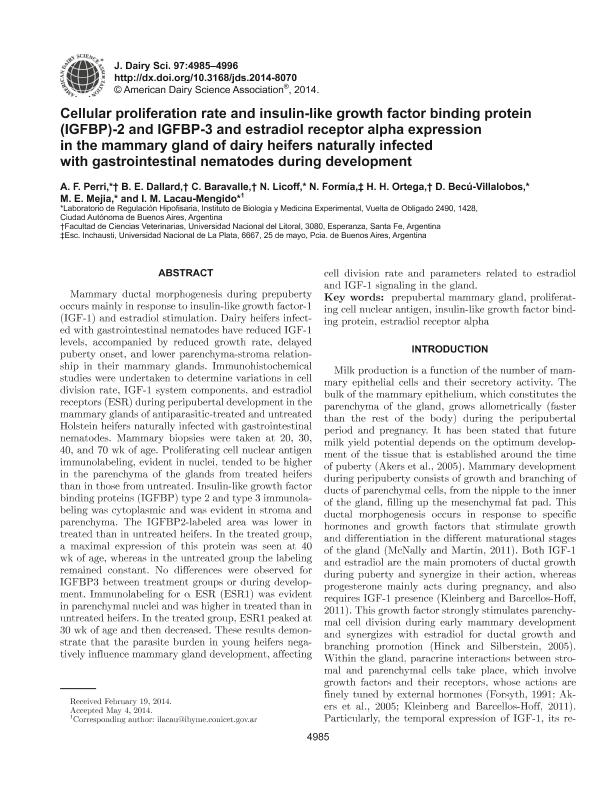Mostrar el registro sencillo del ítem
dc.contributor.author
Perri, Adrián Francisco

dc.contributor.author
Dallard, Bibiana Elisabet

dc.contributor.author
Baravalle, Celina

dc.contributor.author
Licoff, N.
dc.contributor.author
Formia, N.
dc.contributor.author
Ortega, Hugo Hector

dc.contributor.author
Becu, Damasia

dc.contributor.author
Mejia, M. E.
dc.contributor.author
Lacau, Isabel Maria

dc.date.available
2016-07-14T20:59:58Z
dc.date.issued
2014-08
dc.identifier.citation
Perri, Adrián Francisco; Dallard, Bibiana Elisabet; Baravalle, Celina; Licoff, N.; Formia, N.; et al.; Cellular proliferation rate, and IGFBP-2 and -3 and estradiol receptor alpha expression in the mammary gland of dairy heifers naturally infected with gastrointestinal nematodes during development; Elsevier; Journal of Dairy Science; 97; 8; 8-2014; 4985-4996
dc.identifier.issn
0022-0302
dc.identifier.uri
http://hdl.handle.net/11336/6518
dc.description.abstract
Mammary ductal morphogenesis during prepuberty occurs mainly in response to insulin-like growth factor-1 (IGF-1) and estradiol stimulation. Dairy heifers infected with gastrointestinal nematodes have reduced IGF-1 levels, accompanied by reduced growth rate,delayed puberty onset, and lower parenchyma-stroma relationship in their mammary glands. Immunohistochemical studies were undertaken to determine variations in cell division rate, IGF-1 system components, and estradiol receptors (ESR) during peripubertal development in the mammary glands of antiparasitictreated and untreated Holstein heifers naturally infected with gastrointestinal nematodes. Mammary biopsies were taken at 20, 30, 40, and 70 wk of age. Proliferating cell nuclear antigen immunolabeling, evident in nuclei, tended to be higher in the parenchyma of the glands from treated heifers than in those from untreated. IGF binding proteins (IGFBP) type 2 and type 3 immunolabeling was cytoplasmic and was evident in stroma and parenchyma. The IGFBP2-labeled area was lower in treated than in untreated heifers. In the treated group, a maximal expression of this protein was seen at 40 wk of age, whereas in the untreated group the labeling remained constant. No differences were observed for IGFBP3 between treatment groups or during development. Immunolabeling for α ESR (ESR1) was evident in parenchymal nuclei and was higher in treated than in untreated heifers. In the treated group, ESR1 peaked at 30 wk of age and then decreased. These results demonstrate that the parasite burden in young heifers negatively influence mammary gland development, affecting cell division rate and parameters related to estradiol and IGF-1 signaling in the gland.
dc.format
application/pdf
dc.language.iso
eng
dc.publisher
Elsevier

dc.rights
info:eu-repo/semantics/openAccess
dc.rights.uri
https://creativecommons.org/licenses/by-nc-nd/2.5/ar/
dc.subject
Parasite
dc.subject
Milk
dc.subject
Mammary Gland
dc.subject
Heifer
dc.subject.classification
Producción Animal y Lechería

dc.subject.classification
Producción Animal y Lechería

dc.subject.classification
CIENCIAS AGRÍCOLAS

dc.title
Cellular proliferation rate, and IGFBP-2 and -3 and estradiol receptor alpha expression in the mammary gland of dairy heifers naturally infected with gastrointestinal nematodes during development
dc.type
info:eu-repo/semantics/article
dc.type
info:ar-repo/semantics/artículo
dc.type
info:eu-repo/semantics/publishedVersion
dc.date.updated
2016-06-15T19:10:33Z
dc.journal.volume
97
dc.journal.number
8
dc.journal.pagination
4985-4996
dc.journal.pais
Estados Unidos

dc.journal.ciudad
Champaign
dc.description.fil
Fil: Perri, Adrián Francisco. Consejo Nacional de Investigaciones Científicas y Técnicas. Instituto de Biología y Medicina Experimental (i); Argentina. Universidad Nacional del Litoral. Facultad de Ciencias Veterinarias; Argentina
dc.description.fil
Fil: Dallard, Bibiana Elisabet. Universidad Nacional del Litoral. Facultad de Ciencias Veterinarias; Argentina
dc.description.fil
Fil: Baravalle, Celina. Universidad Nacional del Litoral. Facultad de Ciencias Veterinarias; Argentina
dc.description.fil
Fil: Licoff, N.. Consejo Nacional de Investigaciones Científicas y Técnicas. Instituto de Biología y Medicina Experimental (i); Argentina
dc.description.fil
Fil: Formia, N.. Universidad Nacional de La Plata; Argentina
dc.description.fil
Fil: Ortega, Hugo Hector. Universidad Nacional del Litoral. Facultad de Ciencias Veterinarias; Argentina
dc.description.fil
Fil: Becu, Damasia. Consejo Nacional de Investigaciones Científicas y Técnicas. Instituto de Biología y Medicina Experimental (i); Argentina
dc.description.fil
Fil: Mejia, M. E.. Consejo Nacional de Investigaciones Científicas y Técnicas. Instituto de Biología y Medicina Experimental (i); Argentina
dc.description.fil
Fil: Lacau, Isabel Maria. Consejo Nacional de Investigaciones Científicas y Técnicas. Instituto de Biología y Medicina Experimental (i); Argentina
dc.journal.title
Journal of Dairy Science

dc.relation.alternativeid
info:eu-repo/semantics/altIdentifier/url/http://www.sciencedirect.com/science/article/pii/S0022030214004251
dc.relation.alternativeid
info:eu-repo/semantics/altIdentifier/doi/http://dx.doi.org/10.3168/jds.2014-8070
dc.relation.alternativeid
info:eu-repo/semantics/altIdentifier/doi/10.3168/jds.2014-8070
Archivos asociados
